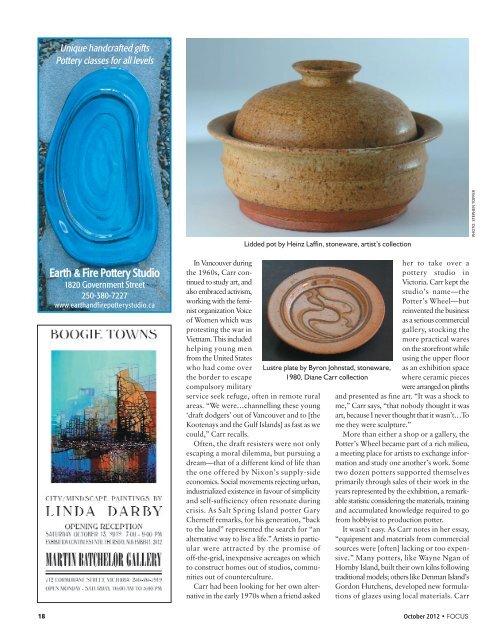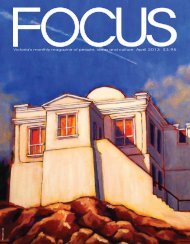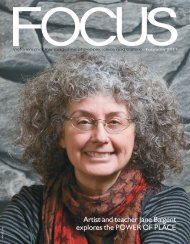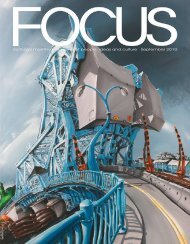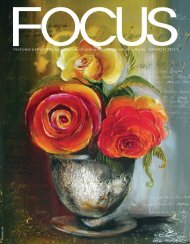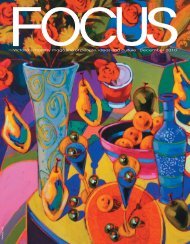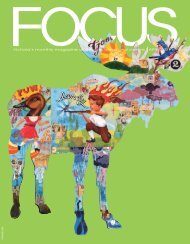**October 2012 Focus - Focus Magazine
**October 2012 Focus - Focus Magazine
**October 2012 Focus - Focus Magazine
Create successful ePaper yourself
Turn your PDF publications into a flip-book with our unique Google optimized e-Paper software.
Unique handcrafted gifts<br />
Pottery classes for all levels<br />
Earth & Fire Pottery Studio<br />
1820 Government Street<br />
250-380-7227<br />
www.earthandfirepotterystudio.ca<br />
Lidded pot by Heinz Laffin, stoneware, artist’s collection<br />
In Vancouver during<br />
the 1960s, Carr continued<br />
to study art, and<br />
also embraced activism,<br />
working with the feminist<br />
organization Voice<br />
of Women which was<br />
protesting the war in<br />
Vietnam. This included<br />
helping young men<br />
from the United States<br />
who had come over<br />
the border to escape<br />
compulsory military<br />
service seek refuge, often in remote rural<br />
areas. “We were…channelling these young<br />
‘draft dodgers’ out of Vancouver and to [the<br />
Kootenays and the Gulf Islands] as fast as we<br />
could,” Carr recalls.<br />
Often, the draft resisters were not only<br />
escaping a moral dilemma, but pursuing a<br />
dream—that of a different kind of life than<br />
the one offered by Nixon’s supply-side<br />
economics. Social movements rejecting urban,<br />
industrialized existence in favour of simplicity<br />
and self-sufficiency often resonate during<br />
crisis. As Salt Spring Island potter Gary<br />
Cherneff remarks, for his generation, “back<br />
to the land” represented the search for “an<br />
alternative way to live a life.” Artists in particular<br />
were attracted by the promise of<br />
off-the-grid, inexpensive acreages on which<br />
to construct homes out of studios, communities<br />
out of counterculture.<br />
Carr had been looking for her own alternative<br />
in the early 1970s when a friend asked<br />
Lustre plate by Byron Johnstad, stoneware,<br />
1980, Diane Carr collection<br />
her to take over a<br />
pottery studio in<br />
Victoria. Carr kept the<br />
studio’s name—the<br />
Potter’s Wheel—but<br />
reinvented the business<br />
as a serious commercial<br />
gallery, stocking the<br />
more practical wares<br />
on the storefront while<br />
using the upper floor<br />
as an exhibition space<br />
where ceramic pieces<br />
were arranged on plinths<br />
and presented as fine art. “It was a shock to<br />
me,” Carr says, “that nobody thought it was<br />
art, because I never thought that it wasn’t…To<br />
me they were sculpture.”<br />
More than either a shop or a gallery, the<br />
Potter’s Wheel became part of a rich milieu,<br />
a meeting place for artists to exchange information<br />
and study one another’s work. Some<br />
two dozen potters supported themselves<br />
primarily through sales of their work in the<br />
years represented by the exhibition, a remarkable<br />
statistic considering the materials, training<br />
and accumulated knowledge required to go<br />
from hobbyist to production potter.<br />
It wasn’t easy. As Carr notes in her essay,<br />
“equipment and materials from commercial<br />
sources were [often] lacking or too expensive.”<br />
Many potters, like Wayne Ngan of<br />
Hornby Island, built their own kilns following<br />
traditional models; others like Denman Island’s<br />
Gordon Hutchens, developed new formulations<br />
of glazes using local materials. Carr<br />
18 October <strong>2012</strong> • FOCUS<br />
PHOTO: STEPHEN TOPFER


